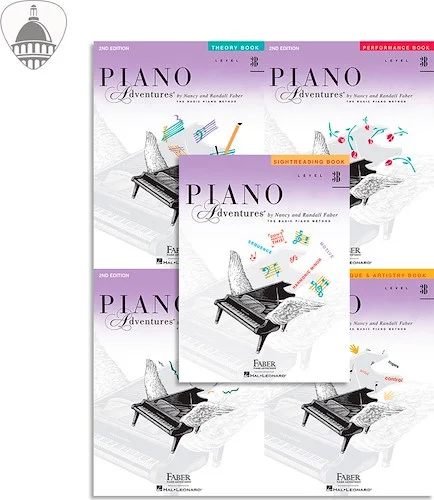Faber Piano Adventures Level 3B Bundle- Lesson, Performance, Technique & Artistry, and Theory Books 5 in 1 Package


Price: $36.99
Qty: 2+ Price: $34.75 each
Ships FREE within 1-4 Days
In Stock
Financing Available: Learn More
Product Description
Get your game on with Faber Piano Adventures Bundle Level 3B all in one package Plus the Sightreading Book!
The hallmark of the revised Level 3B Theory Book is the synthesis of 3B concepts: major and minor scales, triads and chord inversions, and 16th-note rhythms are reinforced with writing, composing, sightreading, and ear-training exercises. Students will enjoy composing a tune for a lead sheet, harmonizing melodies, identifying triad inversions, and creating their own 16th-note rhythms in various time signatures.
The 2nd Edition of the 3B Performance Book offers appealing, pianistic pieces that closely correlate with the Lesson Book concepts. Students will enjoy a German Dance by Beethoven and a selection from the Notebook for Anna Magdalena Bach, as well as arrangements by Strauss, and a four-hand duet by Felix Mendelssohn. Well-loved standards such as “Hava Nagila” and “The Star-Spangled Banner,” along with new originals by the Fabers, provide a variety of major and minor keys, accompaniment styles, and pianistic expression.
The 2nd Edition of the Level 3B Lesson Book is a fresh, dynamic update for early-intermediate students. This is the level of contrasts: fast fingerwork contrasted with sonorous tonal colors, and traditional harmonies mingled with contemporary sounds. Compositions from Dvorak, Rebikov, and Liszt are included along with new Faber originals.
In the Level 3B Technique & Artistry Book, students learn four effective Technique Secrets to help develop fluency for early-intermediate repertoire. New etudes by Bertini, Beyer, and Czerny are used to review and apply the Secrets, leading to Artistry Magic pieces that are suitable for recital performance.
As the music becomes more complex, an initial scanning of the music is greatly encouraged: Is the key in major or in the relative minor? Spot the rhythm pattern used throughout. Plan how you will play the last arpeggiated chord. Students gain experience in C and Am, G and Em, F and Dm. Concepts extend to chord inversions, the octave, and 16th note patterns. Occasional Rhythm Road exercises invite tapping and writing work.
The hallmark of the revised Level 3B Theory Book is the synthesis of 3B concepts: major and minor scales, triads and chord inversions, and 16th-note rhythms are reinforced with writing, composing, sightreading, and ear-training exercises. Students will enjoy composing a tune for a lead sheet, harmonizing melodies, identifying triad inversions, and creating their own 16th-note rhythms in various time signatures.
The 2nd Edition of the 3B Performance Book offers appealing, pianistic pieces that closely correlate with the Lesson Book concepts. Students will enjoy a German Dance by Beethoven and a selection from the Notebook for Anna Magdalena Bach, as well as arrangements by Strauss, and a four-hand duet by Felix Mendelssohn. Well-loved standards such as “Hava Nagila” and “The Star-Spangled Banner,” along with new originals by the Fabers, provide a variety of major and minor keys, accompaniment styles, and pianistic expression.
The 2nd Edition of the Level 3B Lesson Book is a fresh, dynamic update for early-intermediate students. This is the level of contrasts: fast fingerwork contrasted with sonorous tonal colors, and traditional harmonies mingled with contemporary sounds. Compositions from Dvorak, Rebikov, and Liszt are included along with new Faber originals.
In the Level 3B Technique & Artistry Book, students learn four effective Technique Secrets to help develop fluency for early-intermediate repertoire. New etudes by Bertini, Beyer, and Czerny are used to review and apply the Secrets, leading to Artistry Magic pieces that are suitable for recital performance.
As the music becomes more complex, an initial scanning of the music is greatly encouraged: Is the key in major or in the relative minor? Spot the rhythm pattern used throughout. Plan how you will play the last arpeggiated chord. Students gain experience in C and Am, G and Em, F and Dm. Concepts extend to chord inversions, the octave, and 16th note patterns. Occasional Rhythm Road exercises invite tapping and writing work.